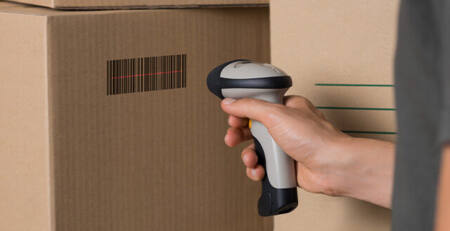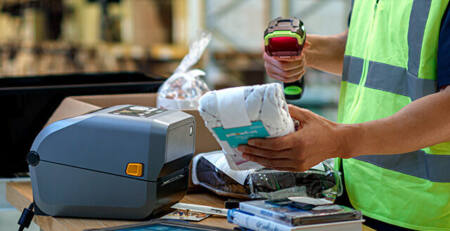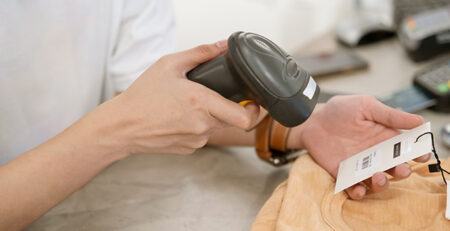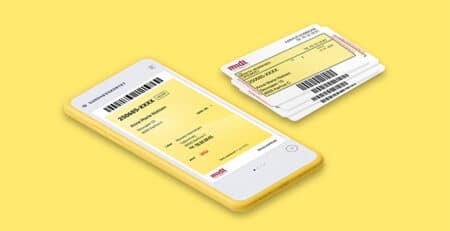Barcode reader vs. hand scanner
You need a solution to scan barcodes efficiently - but should you choose a barcode reader or a hand scanner?

Imagine yourself in the middle of a busy warehouse. Packages are being moved, orders need to be registered quickly, and errors can cost time and money. You need a solution to scan barcodes efficiently – but should you choose a barcode reader or a hand scanner?
Many people think the two terms mean the same thing, but there are significant differences that can make a big difference depending on your needs. The right choice can increase your efficiency, reduce errors and ensure a smooth workflow.
In this guide, we give you a clear overview of the difference between a barcode reader and a hand scanner so you can make the best decision for your business.
Read on to find out which solution is best for your business!
What is a barcode reader?
A barcode reader is a stationary or handheld device that reads and translates information from a barcode into digital data. It uses either laser, imaging technology (imager) or CCD sensors to capture barcodes quickly and accurately.
How does a barcode reader work?
When a barcode reader detects a barcode, it sends data to a connected system, such as a computer, POS system or inventory management software. This is often done via USB, Bluetooth or RF wireless technology, depending on the specifications of the device.
Benefits of a barcode reader:
- High precision: Scans quickly and accurately, even on small or damaged codes.
- Flexible placement: Can be used stationary on POS systems or integrated into production lines.
- Automated scanning: Some models feature hands-free scanning, making them ideal for busy workplaces.
- Long range: Depending on the model, some barcode readers can scan from several meters away.
Disadvantages of a barcode reader:
- Less mobility: Stationary models require objects to be moved past the scanner.
- Power supply dependent: Most barcode readers require a fixed power supply or charging.
Where are barcode readers used?
- Retail: Often used in checkout systems for fast checkout.
- Warehouse & Logistics: Fixed scanners detect goods in motion.
- Healthcare: Scan medication and patient wristbands to ensure accurate data.
- Production: Part of quality control and process management.
Barcode readers are an ideal solution for businesses that need fast, accurate and stationary scanning. But how do they differ from handheld scanners? We’ll take a closer look in the next section.
What is a hand scanner?
A handheld scanner is a handheld device that reads barcodes manually by pointing the scanner at a barcode and activating a trigger button. Handheld scanners are often designed with an ergonomic pistol grip, making them easy to use for extended periods of time.
How does a hand scanner work?
Handheld scanners typically work via USB, Bluetooth or wireless RF technology, making them flexible in use. When a barcode is scanned, data is sent directly to a computer, inventory management system or point of sale (POS) system. Depending on the model, handheld scanners can either use laser, imager technology or CCD sensors to read barcodes.
Benefits of a hand scanner:
- Mobility: The user can move around freely and scan items without being limited by a fixed station.
- Flexibility: Can be used in many different environments, from retail to warehouse management and logistics.
- Ease of use: Ergonomic design makes them comfortable to hold and easy to operate.
- Wireless options: Many models offer Bluetooth connectivity, eliminating the need for cables.
Disadvantages of a hand scanner:
- User action dependent: Requires an employee to manually scan each item.
- Shorter range: Most handheld scanners work best within a short distance.
- Battery life: Wireless models require charging, which can be a factor in labor-intensive environments.
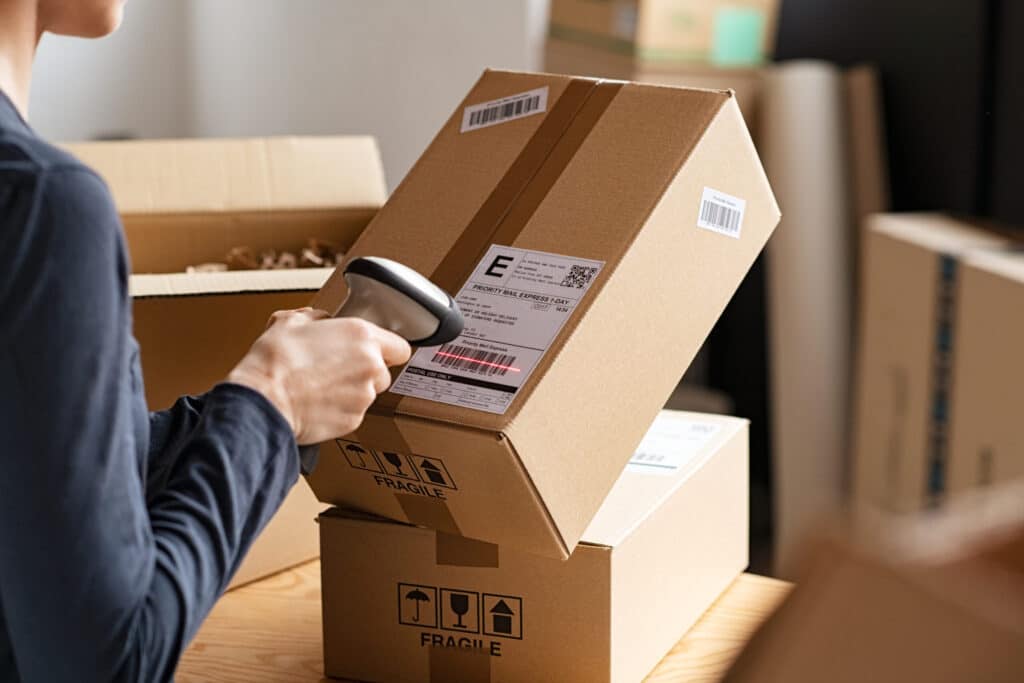
Where are handheld scanners used?
- Retail: Used at checkouts and for inventory counting.
- Inventory management: Effective for scanning products directly from shelves or pallets.
- Logistics and shipping: Used to scan parcels upon receipt and dispatch.
- Healthcare: Used for scanning medication, patient records and samples.
Handheld scanners are ideal for businesses where mobility and flexibility are important, but how do they differ from barcode readers in practice? In the next section, we take a closer look at the key differences.
Key differences between a barcode reader and a hand scanner
Although both a barcode reader and a hand scanner read barcodes, they are used in different ways. Your choice depends on how and where you need to use the scanner.
Use and function
A barcode reader is often stationary and scans automatically without manual operation. It is ideal for shops, production lines and warehouses where fast and efficient scanning is needed.
A hand scanner requires the user to point it at a barcode and press a button. It’s perfect for tasks where flexibility is needed, such as inventory counting, receiving and logistics.
Scanning distance
Barcode readers can often scan from several meters away and in some cases read multiple codes at once. They are often used in situations where products need to be registered quickly.
Handheld scanners work best when held close to the barcode. They are great for precision work where the employee has to manually scan items in one place at a time.
Connectivity and flexibility
Stationary barcode readers are typically connected via cable to a POS system or computer, ensuring a stable connection.
Handheld scanners are available in both wired and wireless models. Wireless hand scanners use Bluetooth or RF technology and offer greater freedom of movement, making them suitable for mobile workflows.
Power supply and battery life
Barcode readers are hardwired for power, ensuring constant operation. This means they can run continuously without recharging.
Handheld scanners, especially the wireless models, use batteries and need to be charged regularly. If the scanner is used all day, battery life can be a crucial factor.
Which solution should you choose?
If you need fast, continuous scanning without manual operation, a barcode reader is the best choice. However, if you need a flexible and mobile solution, a handheld scanner is a better alternative.
In the next section, we take a closer look at what factors you should consider before choosing a solution.
Considerations when choosing a solution
When choosing between a barcode reader and a handheld scanner, there are several factors to consider. Your choice depends on how you will use the scanner and the needs of your business.
1D or 2D scanning
An important decision is whether to scan 1D barcodes (the classic, line-shaped barcodes) or 2D codes (like QR codes and data matrix codes). All handheld scanners and barcode readers can read 1D codes, but if you work with 2D codes, you should choose a model that supports this.
Wireless or wired
If the scanner is to be used at a fixed workstation, such as a checkout system or packing line, a wired model may be the best option. It requires no charging and has a stable connection.
However, if you need to move around with the scanner, for example in a warehouse or store, a wireless handheld scanner can provide greater flexibility. Wireless models use either Bluetooth or RF technology and offer greater freedom of movement.
Work environment and resilience
It is important to consider where the scanner will be used. If it will be used in a retail store or office environment, a standard model is often sufficient.
However, if the scanner will be used in a demanding environment, such as a warehouse or production facility, you may want to choose a robust model that can withstand shocks, drops and dust. Models with a high IP rating are dust and water resistant and can withstand rough use.
Battery life and runtime
When choosing a wireless handheld scanner, it’s important to consider battery life. Some models can hold power throughout the working day, while others require charging during the day. If the scanner will be used intensively, a model with replaceable batteries can be a good option.

Connectivity and compatibility
Make sure the scanner is compatible with your current system. Most models work via USB, Bluetooth or RF wireless technology, but it’s important to choose a model that suits your needs.
By considering these factors, you can find the solution that best matches your business requirements. In the next section, we look at why Delfi Technologies is the right choice when investing in a new scanner.
Why choose Delfi Technologies?
The choice between a barcode reader and a handheld scanner depends on your needs. If you need to scan quickly and stationary, a barcode reader is the obvious choice. If you need mobility and flexibility, a handheld scanner is the best option.
At Delfi Technologies, we have over 33 years of experience in providing customized scanning solutions for the retail, warehouse, logistics and healthcare sectors. We work with leading manufacturers such as Zebra, Datalogic and Honeywell, ensuring you the best quality and technology on the market.
Whether you need a desktop barcode reader for the checkout or a wireless handheld scanner for the warehouse, we can help you find the optimal solution. Our experts are ready to advise you on which scanner is best for your business.
Find the perfect scanner for your business here or contact us for professional guidance.

